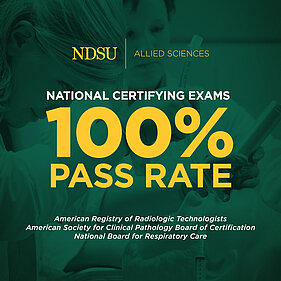
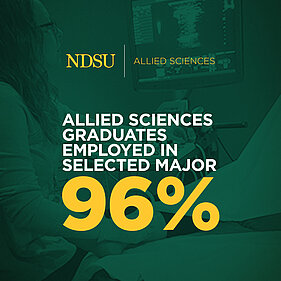
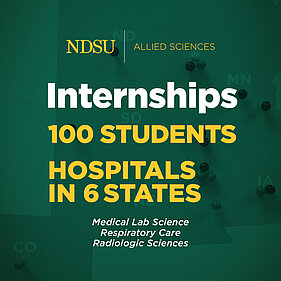
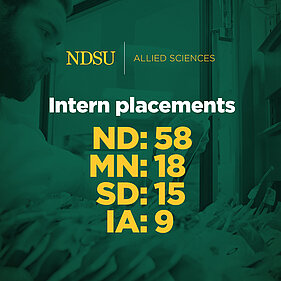
About the Professions
Professions in the allied sciences field require you to be interested and have an aptitude in the sciences. Career opportunities exist in many different settings: hospitals, clinics, private laboratories, imaging centers, sleep clinics, research, public health, sales and marketing, consulting, health administration, education, and more.
With a bachelor's of science degree from NDSU, major in one of the allied sciences programs that fits your career goals.
According to the US Department of Labor Bureau of Lab Statistics, employment in allied sciences fields continues to grow. Check out the labor statistics for medical laboratory scientists, radiologic technologists, sonographers, and respiratory therapists.
Medical Laboratory Scientist
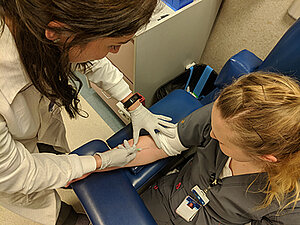
Medical laboratory scientists use analytical procedures and complex instruments to perform tests on blood and body fluids that assist physicians in patient diagnosis and treatment, disease monitoring and prevention. Because the tests performed are so vital in medical treatment, the medical laboratory scientist must know not only how to perform these tests with scientific precision and accuracy, but must be well educated in the underlying scientific principles and clinical significance of the results.
The principle areas of practice in the laboratory are chemistry, hematology, microbiology, urinalysis, immunohematology and immunology. In addition to performing laboratory tests, MLS professionals also assist to interpret test results in conjunction with patient information and communicate their meaning to other healthcare team members. They monitor quality controls, conduct research, develop new tests and methods, and supervise personnel. While direct patient contact is limited, these individuals enjoy being a part of the healthcare team.
To learn more about pursuing an education and career in medical lab science visit:
Radiologic Technologist
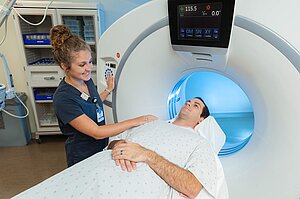
Radiologic technologists, also known as radiographers, perform diagnostic imaging examinations, accurately position patients, ensure quality diagnostic images are produced, and adhere to radiation protection regulations for themselves, their patients, and coworkers. They work closely with radiologists, the physicians who interpret medical images, to diagnose or rule out disease or injury.
Multi-skilled RT(R)s who are educated and credentialed in more than one type of imaging technique are the most marketable. With experience and additional education, RTs may become specialists in CT, mammography, and magnetic resonance imaging (MRI), or advance into management or education. Radiation therapy, sonography, and nuclear medicine typically require additional specialized education in a dedicated training program.
To learn more about education and careers in radiologic technology visit:
Sonographer

Sonographers are highly skilled health care professionals who use special equipment and high frequency sound waves (ultrasound) to create images of internal body structures and organs. They have a high level of patient interaction and play a vital role in providing the physician with images to interpret, assess, and diagnose medical conditions or conduct surgical procedures.
Echocardiographers, also known as cardiac sonographers, evaluate the anatomy and hemodynamics (blood flow) of the heart, its chambers and valves, and related blood vessels. Diagnostic medical sonographers evaluate abdominal structures like the kidney, liver, and spleen, breast tissue, the reproductive system, blood vessels, fetal development, and musculoskeletal structures like tendons and joints.
To learn more about education and careers in sonography visit:
Respiratory Therapist
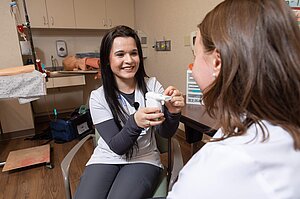
Respiratory Care is a rewarding field dedicated to helping patients with cardiopulmonary (heart-lung) disorders, like asthma, cystic fibrosis, trauma, and post-operative complications. The practice of Respiratory Care encompasses diagnostic evaluation, therapy, and education of patients found in neonatal/pediatric units, adult general and intensive care units, pulmonary function labs, pulmonary rehabilitation, and home care. RTs work closely with physicians, nurses, and other health professionals to deliver direct bedside care to patients of all ages.
Diagnostic activities include obtaining and analyzing sputum and blood specimens, performing breathing studies to determine if lung function is impaired, performing sleep disorder studies, and interpreting the data obtained from these.
Therapy includes administering medical gases and respiratory medications to alleviate breathing problems, applying and monitoring mechanical ventilatory and cardiovascular support, maintaining artificial airways, and performing bronchopulmonary hygiene procedures and cardiopulmonary rehabilitation activities.
Respiratory therapists also educate the patient, family and public to promote knowledge of cardiopulmonary disease, medical therapy and wellness.
To learn more about education and careers in respiratory care visit:


